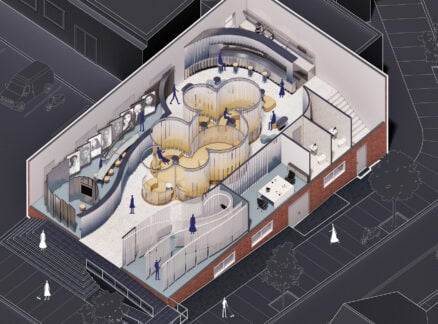January 1, 2011
Design Among the Dunes
Matali Crasset tries her hand at an experimental ecolodge in the Tunisian desert.
DESIGNER: Matali Crasset
www.matalicrasset.com
PROJECT: Dar Hi
www.dar-hi.net
Nefta,
Tunisia
Opening a hotel is always a bit of a gamble, but the French hoteliers Patrick Elouarghi and Philippe Chapelet seem particularly comfortable taking risks. They are wagering that Dar Hi, their new desert retreat in Nefta, Tunisia, will have enough draw to turn a remote corner of the country—best known as a backdrop for the Star Wars films—into a popular destination for European ecotourists. Their ace in the hole is the Parisian industrial designer Matali Crasset, who also collaborated with the duo in 2003 on the Hi Hotel, in Nice, France. With Dar Hi, Crasset proves that she can make her distinctly colorful and quirky style work in the incongruous desert landscape, designing a cluster of buildings that speak directly to the Tunisian climate and culture.
The project marks Crasset’s first foray into architecture—she designed the buildings, then worked with a local architect, Mohamed Nasr, to execute them—although she is unfazed by the expansion of her practice. “It’s not that different than doing any other project, because I’m starting from the interior,” she says.
Crasset’s approach for Dar Hi was to design three distinct typologies—named the Pill, the Dune, and the Troglodyte—which she developed after a two-year period studying Nefta’s culture and vernacular architecture. Raised at varying heights on brick piles, the Pill buildings boast expansive ribbon windows and views of the cityscape, the desert, and the historic salt lake Chott el Djerid. By contrast, the Troglodytes create the effect of living within a communal recess. (They are somewhat less subterranean versions of traditional dwell-ings found in Matmata, to the east.) The Dunes open out onto the desert and are meant to feel as if they were sculpted out of the sand. “I have conceived an architecture that is toward the indoor when outside and toward the outdoor when inside,” Crasset says.
No matter where they’re staying, all of Dar Hi’s guests should feel steeped in local flavor, particularly when eating one of the many traditional family meals prepared by hotel cooks (14 of the hotel’s 15 staff members are locals) with produce supplied by Dar Hi’s own potager. The idea was to create a space that felt like home, where informality was built into every architectural detail, including the spacious geothermal spa. Upon entering the complex, guests are even encouraged to trade their civilian kicks for babouches (traditional Tunisian slippers). None of the units have a television or a phone—part of an effort to get guests to spend more time hanging out in the ample communal spaces, which Crasset left “as open as possible.”
If the final effect is somewhat atypical of a luxury resort, well, that’s just a testament to Dar Hi’s success at authentically capturing Nefta’s singular spirit and landscape. As Crasset says, “The flight is only two hours and fifteen minutes from Paris, but when you arrive you feel like you’re at the end of the world.”





